Selecting the right greenery for an office plant can enhance the aesthetics of the space while also offering benefits such as improved air quality and reduced stress levels.
Potted succulents and cacti are especially popular among those seeking to decorate their office desks with plants. This is due to their low maintenance requirements and the minimal space they occupy.
They are known for their ability to thrive in less than ideal lighting conditions typically found in office settings. Their need for infrequent watering also aligns well with the busy schedules of professionals.
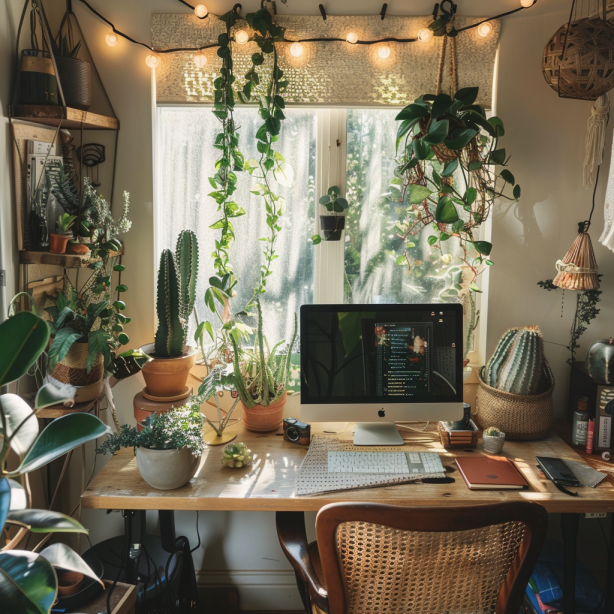
With a wide variety of succulents and cacti available, choosing the right plant can be both an easy and tailored experience based on an individual’s office environment and personal preference.
Office succulents that are particularly well-suited to indoor conditions include species like Aloe, Jade plants, and Echeveria. These are celebrated not only for their resilience but also for their aesthetic diversity and the minimal care they necessitate.
When integrating potted succulents and cacti into an office setting, it is important to consider factors such as available light, ambient temperature, and space.
These plants often prefer bright, indirect light, but some can adapt to lower light levels, making them versatile for various desk locations.
Regular monitoring and a basic understanding of their needs can ensure these plants remain a vibrant and enduring addition to any office desk.
Choosing the Right Succulents and Cacti
Selecting the ideal succulents and cacti for an office desk involves considering the lighting conditions and available space. You should also ensure the chosen varieties are suitable for the work environment, especially if pets are present.
Low Light Tolerant Varieties
Succulents and cacti that tolerate low light are fitting for offices with limited natural light.
Snake plants (Sansevieria) and ZZ plants (Zamioculcas zamiifolia) are two stellar examples. Each can thrive under artificial lights or in dim corners. Both require minimal watering, contributing to their low-maintenance profile.
- Snake Plant: Survives in low light; water sparingly.
- ZZ Plant: Prefers low to moderate light; allows for infrequent watering.
Bright Light Loving Species
For a desk situated near a window or under strong artificial light, one should direct their attention to bright light aficionados such as Aloe vera and certain cactus species.
These plants can bask in direct sunlight, harnessing the rays to fuel their growth, albeit with a need for more consistent watering than their low-light counterparts.
- Aloe Vera: Requires bright, indirect sunlight; moderate watering.
- Cactus: Flourishes in direct sunlight; infrequent, thorough watering.
Assessing Space and Size for Desk Plants
When incorporating greenery into a workspace, the physical limitations are key. One should measure the desk area to ensure an appropriate fit.
Dwarf cacti and miniature succulents are excellent choices, as they occupy less space and typically grow slowly, minimizing the need for frequent repotting.
- Desk Size: Select plants that will not overcrowd the space.
- Growth Rate: Opt for slow-growing varieties to limit maintenance.
Considering Plant Toxicity
In environments frequented by pets, plant toxicity is a serious concern.
Many succulents, such as Haworthias and certain Echeverias, are non-toxic and thus safer choices for pet-friendly offices. Conversely, one should be aware that some succulents and cacti, like Aloe vera, can be harmful if ingested.
- Pet-Friendly Succulents: Choose Haworthias or Echeverias for safety.
- Toxic Plants: Keep Aloe vera and similar species out of pets’ reach.
Caring for Your Office Plants
Selecting low-maintenance indoor plants like succulents and cacti for your office desk is an excellent choice due to their minimal watering needs and adaptability to indoor conditions.
To ensure the vitality of these plants, it is crucial to understand their specific care requirements.
Watering Requirements
Succulents and cacti thrive with less water than other plants.
Watering should only be done when the soil is completely dry to the touch. Overwatering can lead to root rot, so it’s best to err on the side of underwatering.
A general guideline is to water these plants every two weeks, but this can vary depending on the office environment.
Proper Indoor Lighting
Although these plants are tolerant of varying light conditions, they do best with plenty of natural light.
Positioning them near a window where they can receive indirect sunlight is ideal. If natural light is insufficient, consider using a grow light to supplement their light needs.
Soil and Drainage Essentials
For succulents and cacti, well-draining soil is essential. A potting mix specifically designed for these types of plants should be used.
Ensure that pots have drainage holes to prevent water from accumulating at the bottom, which can cause the roots to rot.
Humidity and Temperature
These plants prefer a dry climate and do well in typical indoor humidity levels.
Succulents and cacti are best kept in conditions that mimic their natural arid habitats. Room temperatures between 60-80 degrees Fahrenheit create an optimal environment for these office-friendly plants.
Popular Desk Succulents and Cacti
Choosing the proper green companions for office desks is essential for aesthetics and air quality. The following selections are particularly well-suited for the indoor environment, providing visual appeal without requiring extensive care.
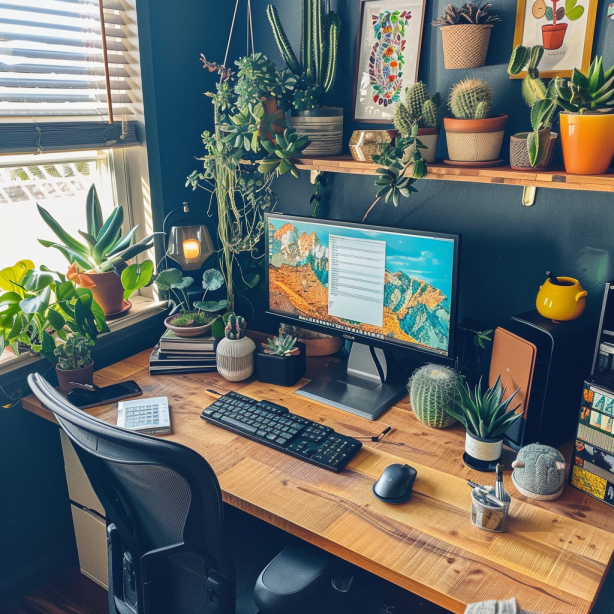
Succulents with Attractive Foliage
Hobbit Jade (Crassula ovata ‘Hobbit’) and Burro’s Tail (Sedum morganianum) are among the succulents praised for their distinctive foliage.
The Hobbit Jade, with its curled leaves resembling small green fingers, provides a whimsical touch to any space. On the other hand, Burro’s Tail, with its cascading stems densely packed with fleshy leaves, creates a striking visual effect when placed in a hanging planter.
- Philodendrons offer an array of leaf shapes and sizes, proving their position as a top choice for those desiring lush green foliage.
- Air Plants (Tillandsia), in contrast, do not even require soil, making them a peculiar yet fascinating display on one’s desk.
- For a variety of hues, Jade Plants (Crassula ovata) can exhibit green, yellow, and red tones depending on sunlight exposure.
Cacti that Thrive Indoors
Cacti are not to be overlooked for office environments, with the Zebra Cactus (Haworthiopsis attenuata) and Euphorbia Trigona proving to be resilient choices.
The Zebra Cactus earns its name from the white stripes adorning its leaves, offering texture and a modern aesthetic. Euphorbia Trigona, also known as the African Milk Tree, brings a touch of the exotic with its upward, vertical growth and minimal water requirements.
Non-Toxic Options for Pet Owners
Pet owners should opt for non-toxic species to keep their furry friends safe.
The Spider Plant (Chlorophytum comosum) is an excellent choice, being not only safe but also proficient in purifying air.
As an additional benefit, it produces offsets that can easily be repotted to share with others or increase one’s collection.
Bamboo varieties, such as Lucky Bamboo (Dracaena sanderiana), can bring a sense of tranquility and are also safe for pets, provided they receive enough filtered light and water.
Design and Aesthetics
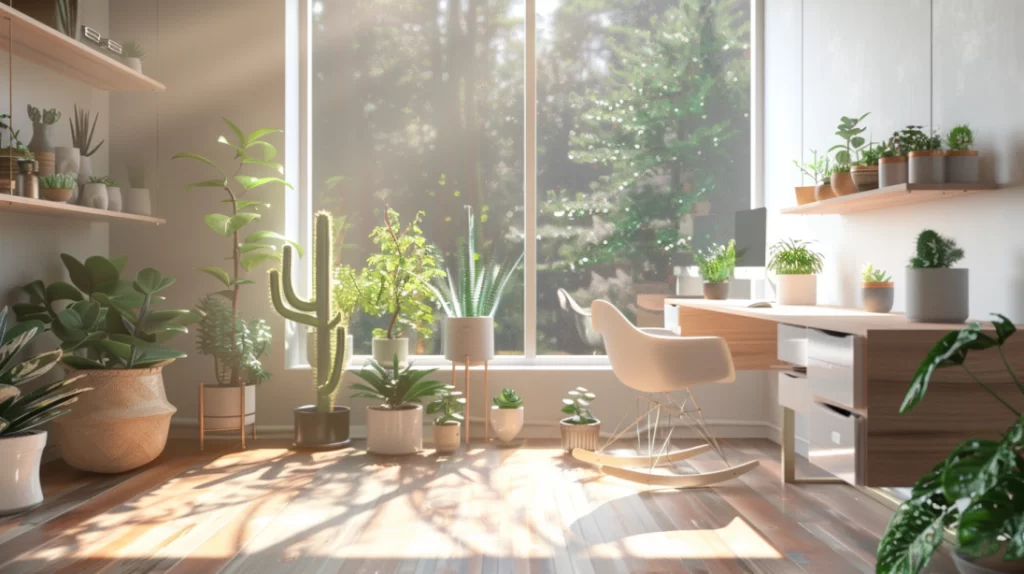
Selecting the right potted succulents and cacti for an office desk involves more than just considering their maintenance requirements. The design and aesthetics of the plants can greatly influence the workspace ambiance.
Container Choices for Succulents and Cacti
When choosing containers for succulents and cacti, materials like terracotta or ceramic offer breathability, which is ideal for root health.
Containers come in various shapes and sizes, from minimalist designs to more elaborate ones, ideal for creating a mini rock garden on your desk.
Keep in mind that the container color can either complement or provide a pop of color against the green, fleshy leaves of the plants.
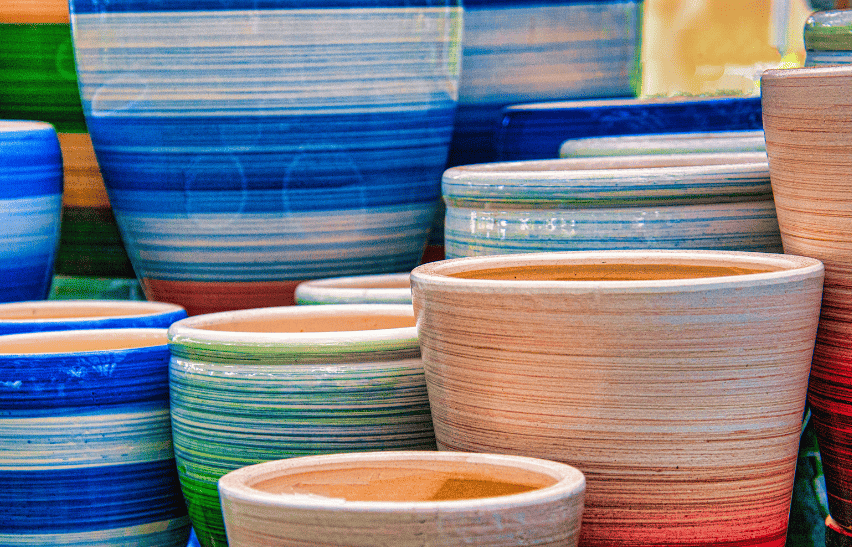
Arranging Plants for Aesthetic Appeal
Arrangement is key to creating an appealing desk garden.
Succulents, such as those with a rosette-shaped pattern, can be the focal point, while smaller filler plants add texture and variety.
For a balanced look, place taller plants like a Christmas cactus towards the back and shorter plants in the foreground. This will give depth and structure to your plant ensemble.
Using Plants to Enhance Feng Shui
In feng shui, plants are believed to bring life energy into a space.
Placement of potted succulents and cacti should aim to create harmony and balance. For example, a plant on the corner of a desk can soften sharp edges, which are considered negative in feng shui.
Additionally, including elements of green can encourage growth and creativity, enhancing the energy of your workspace.
Health and Environmental Benefits
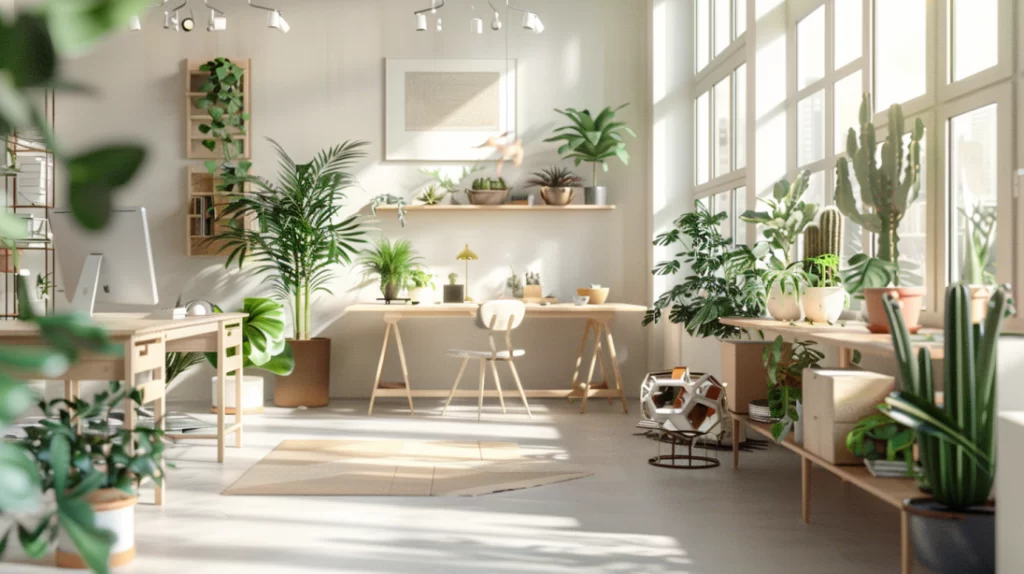
Potted succulents and cacti offer more than an aesthetic appeal for office desks. They contribute positively to health and environmental factors within the workspace.
Air Purification and Circulation
Succulents and cacti are natural air purifiers. They absorb carbon dioxide and release oxygen, enhancing air quality and encouraging better air circulation. A study suggests that having plants in the office can help remove harmful substances called volatile organic compounds (VOCs) from the air, thus mitigating adverse health effects associated with poor indoor air quality.
- Cacti: Known to improve indoor air by removing VOCs.
- Succulents: Effectively refresh the air by releasing oxygen, particularly at night, making them ideal for maintaining a consistent air quality round the clock.
Psychological Benefits of Plants at Work
The presence of plants such as trailing succulents or a petite fern on work desks can offer significant psychological benefits. They are noted for their role in:
- Enhancing Productivity: The greenery provides a visual rest from the computer screen, potentially increasing concentration and work efficiency.
- Stress Reduction: Interacting with plants can decrease stress levels, leading to a more relaxed work environment.
Advanced Care Tips
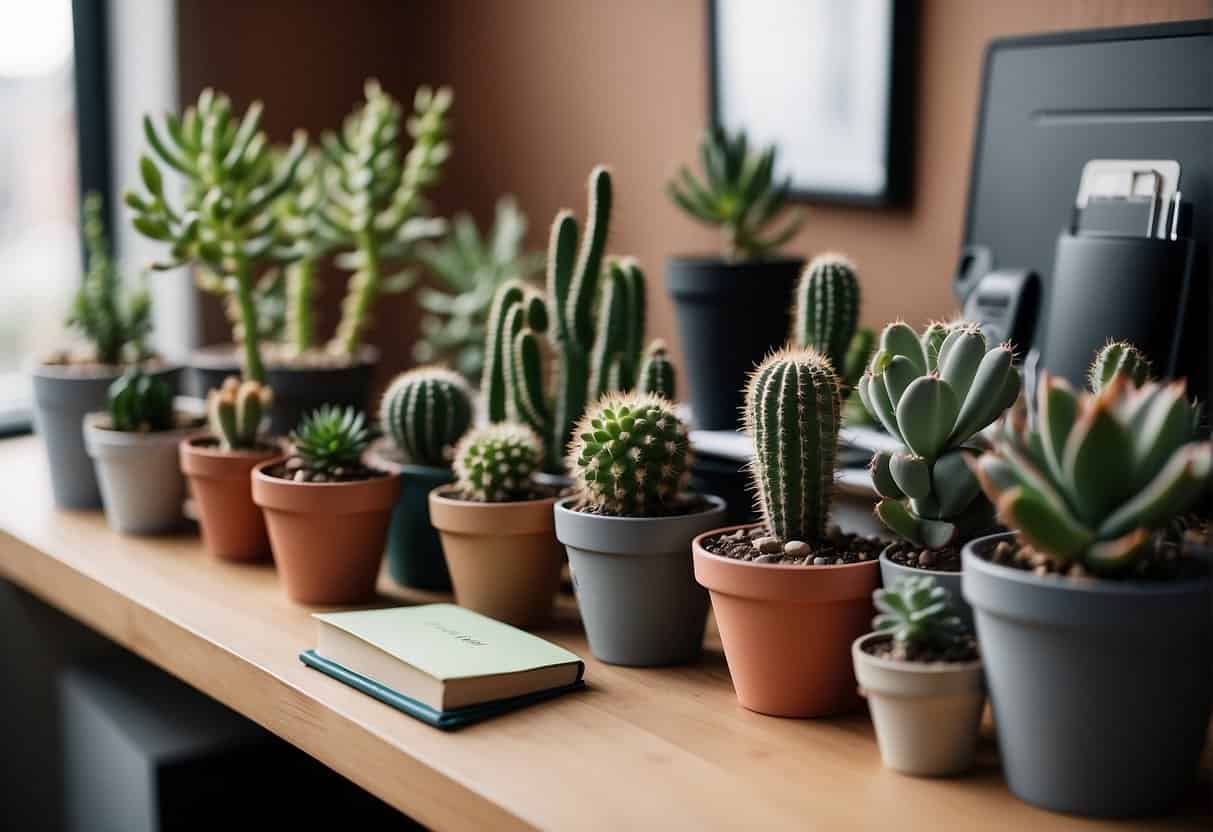
Caring for potted succulents and cacti extends beyond the basics of watering and light. A deeper understanding of pest management and fertilization can enhance plant health and vigor.
Dealing with Pests and Diseases
Succulents and cacti are generally hardy; however, they can fall prey to pests such as aphids, mealybugs, and spider mites. Dealing with these pests promptly is essential.
For mild infestations, you can apply a solution of 70% isopropyl alcohol with a spray bottle or a cotton swab directly to the affected areas. For prevention and maintenance, ensure good airflow around the plants and avoid overwatering.
When it comes to diseases, overwatering is a common culprit that leads to root rot. To prevent this, ensure pots have adequate drainage and the soil dries out between waterings.
Fertilization and Growth
Succulents and cacti, like the slow-growing prickly pear cactus, thrive with minimal fertilization. They benefit from a light application of a low-nitrogen fertilizer or a weak compost tea once during the spring.
Over-fertilization can lead to weak, unnatural growth, so restraint is critical.
- Fertilization Schedule:
- Spring: Apply once with a balanced, diluted mixture.
- Summer: Monitor growth; fertilize sparingly if needed.
- Fall/Winter: No fertilization; let the plants rest.
For those looking to promote growth or bloom in their succulents and cacti, grow lights can be an effective tool. Especially in office environments where natural light is insufficient, these lights should mimic the natural solar spectrum and be placed close enough to provide adequate light without overheating the plants.
Make sure to choose grow lights that are easy to maintain and do not require frequent changes to avoid disrupting the growth cycle of the slow-growing cactus species.
Innovative Office Plant Ideas
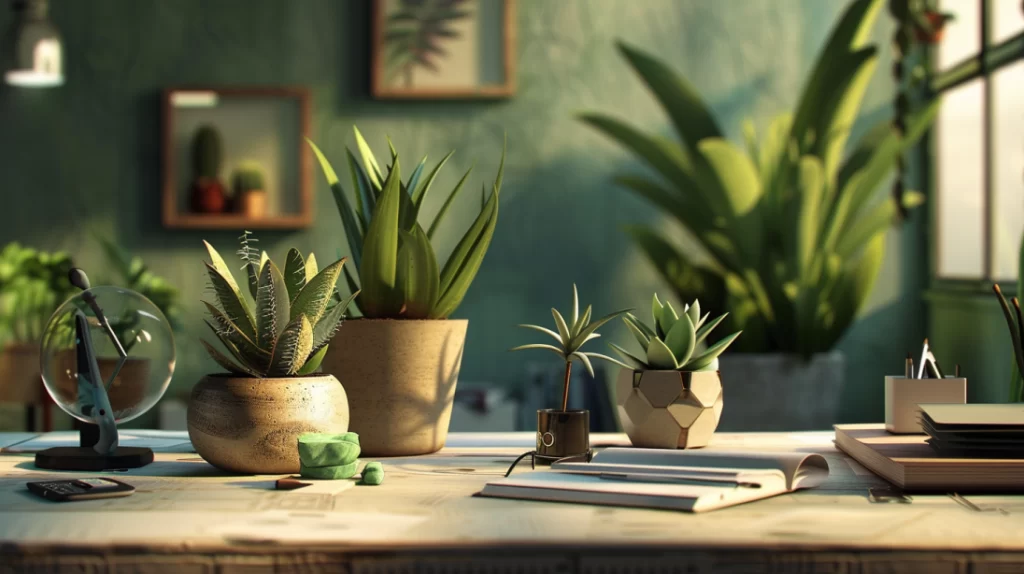
When considering potted succulents and cacti for office desks, the goal is to blend aesthetic appeal with practicality.
Succulents like Aloe Vera (Aloe barbadensis) and Peperomia Plant offer more than just easy maintenance; their sculptural forms add a modern touch while purifying the air.
| Plant | Visual Appeal | Maintenance Level |
|---|---|---|
| Aloe Vera | Striking green succulent | Low; infrequent watering |
| Peperomia Plant | Variety of textures/colors | Moderate; tolerant of fluctuating office light |
Incorporating Hoya Kerri, commonly known as the Sweetheart Plant, can infuse a sense of whimsy with its heart-shaped leaves.
Paired with Rex Begonias, with their vibrant foliage, they create a dynamic display.
- Lucky Bamboo stands out for both its name, suggesting good fortune, and its versatility in growing within water or soil.
- The Mona Lisa variety of peace lily introduces broad, dark green leaves and elegant white flowers, symbolizing peace and prosperity, making them a thoughtful addition to any professional setting.
To invite a playful note into the workspace, consider hanging or wall-mounted planters. These can house small succulents like Aloe Vera or trailing plants, maximizing desk space and drawing the eye upward.
Troubleshooting Common Issues

When maintaining potted succulents and cacti such as English ivy, weaving fig tree, or lace aloe on office desks, one may encounter several common issues. Approach each problem with a methodical assessment to ensure the plant thrives in its environment.
Overwatering: Succulents and cacti require minimal water. Signs of overwatering include yellowing leaves and a heavy or waterlogged pot. Allow the soil to dry between watering sessions to prevent root rot. Detailed care tips for overwatered plants can be found at Leaf & Joy.
Underwatering: Wilted or wrinkled leaves often signal underwatering. A careful balance is crucial; they should receive enough water for their soil to become moist but not saturated.
Sunlight Exposure: All plants need sunlight, but too much direct exposure can lead to sunburn, especially for the lace aloe. Similarly, the weaving fig tree prefers bright, indirect light. Observe and adjust their positions to avoid sun damage.
Legginess: Leggy succulents suggest insufficient light. If your succulents become elongated or stretch out towards the light, they may need a sunnier location or a grow light to correct their growth.
Pest Issues: Keep a watchful eye for pests and address infestations quickly. Gentle cleaning of leaves with a damp cloth or soft paintbrush can remove bugs and dust. Learn more about dealing with pests at Architectural Digest.
Nutrient Deficiency: Lackluster growth might mean your plant requires fertilization. Employ a balanced, diluted fertilizer suitable for succulents and cacti, following the manufacturer’s instructions.
Utilize the following table for quick troubleshooting:
| Issue | Symptom | Solution |
|---|---|---|
| Overwatering | Yellowing leaves, heavy pot | Reduce watering |
| Underwatering | Wilted leaves | Increase watering slightly |
| Sun Damage | Sunburned leaves | Adjust light exposure |
| Legginess | Elongated plant growth | Provide more light |
| Pests | Visible bugs, damaged leaves | Clean leaves, address infestation |
| Nutrient Deficiency | Slow growth, pale leaves | Apply suitable fertilizer |
Succulents and Cacti Plant Profiles
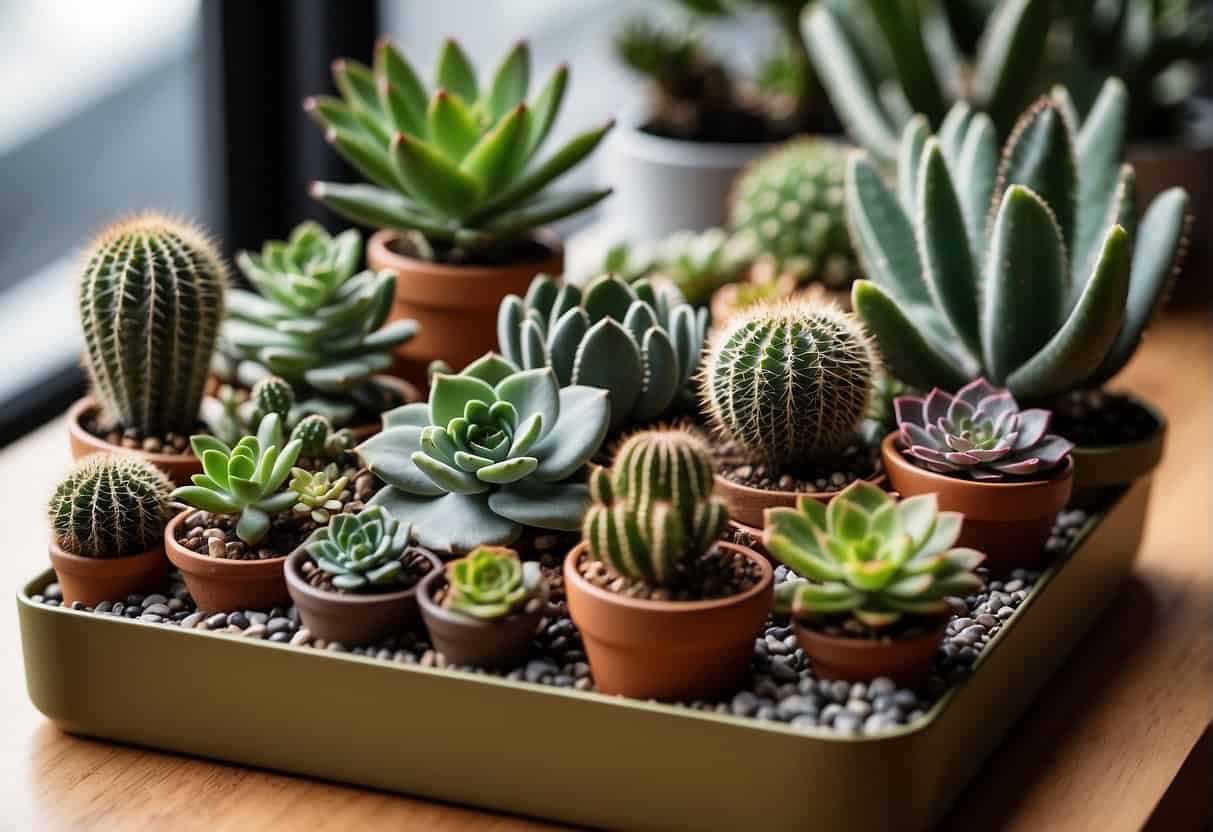
This section provides plant profiles for select succulents and cacti suited for office environments, focusing on their low-maintenance qualities and aesthetic appeal on office desks.
Aloe Species Overview
Aloe species, including the well-known Aloe barbadensis (Aloe Vera), are beneficial for an office setting due to their air-purifying qualities and ease of care. They prefer bright, indirect light and minimal watering, making them ideal for busy workplaces.
Detailed Look at Jade Plants
Crassula ovata, commonly known as the Jade Plant, is a stout, branching succulent with glossy, fleshy leaves that sometimes reveal a red tinge on their edges. These hardy plants thrive with ample light and occasional watering, symbolizing prosperity and good luck.
Understanding the Unique Parodia Schumanniana
The Parodia schumanniana, a type of cactus with a globular shape and vibrant yellow blooms, brings visual interest to any desk without requiring constant attention. They need a well-draining soil mix and occasional watering to prevent root rot.
Appreciating the African Milk Tree
Euphorbia trigona, or the African Milk Tree, is a striking, upright plant with thorny ridges and small leaves. It’s a drought-tolerant succulent that adds height and drama to a space while being forgiving of less-than-perfect care routines.
Discovering the Easter Cactus
The Easter Cactus is a friendly cactus species. It rewards its owner with stunning flowers in the spring. As long as it’s kept in bright indirect light and not overwatered, this plant can flourish in the controlled climate of an office.
Frequently Asked Questions
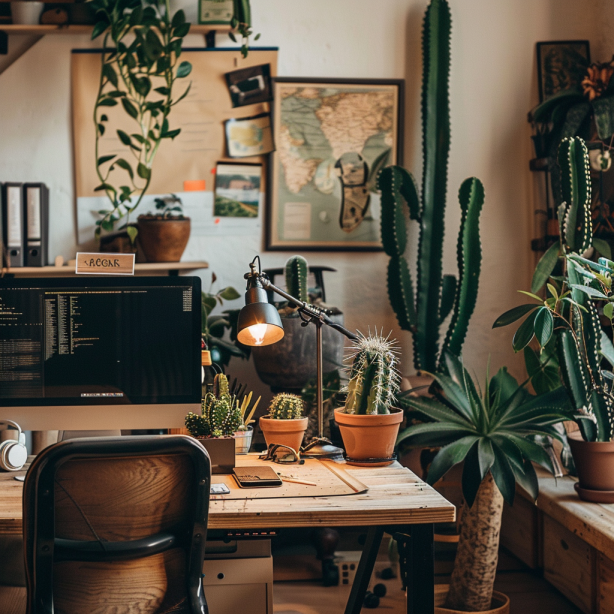
When selecting plants for an office, it’s essential to consider varieties that are both visually appealing and low-maintenance. This is to cater to the unique conditions of the office environment.
What are some low-maintenance succulent varieties suitable for office environments?
Several succulent varieties excel in office settings due to their minimal care requirements. The Jade Plant (Crassula ovata) and Dwarf Jade (Portulacaria afra) are popular options. They thrive with infrequent watering and moderate to bright light.
Which small cacti are best for keeping on an office desk with limited space?
For compact spaces, small cacti like the Christmas Cactus or the Fairy Castle Cactus provide a touch of greenery without occupying much room. This makes them ideal companions for busy office desks.
How do I care for potted succulents in a low-light office setting?
Care for potted succulents in low-light offices by choosing species tolerant to such conditions, such as the Snake Plant or certain Aloe species. Water sparingly, as these plants can thrive with minimal moisture and indirect light.
Which plants are known to bring good luck when placed on an office desk?
The Lucky Bamboo is regarded as a plant that brings good fortune according to feng shui principles. Its low maintenance and ability to grow in low light make it a favored choice for office desks.
What are the most durable small plants that can thrive on an office desk?
Succulents like Haworthia or Echeveria are among the most durable small plants suited for an office desk. They require minimal care and can withstand less-than-ideal conditions commonly found in office settings.
Which indoor plants are recommended for someone with a busy work schedule?
For those with a demanding work life, the ZZ plant (Zamioculcas zamiifolia) and the Spider Plant are excellent choices. These plants can handle neglect, irregular watering, and varying light conditions.

